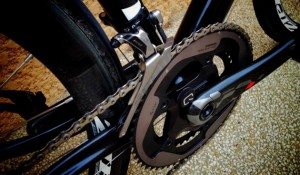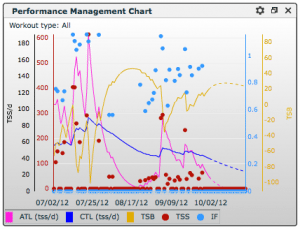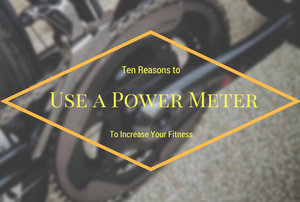A power meter has become ubiquitous with performance in the past few years, and their popularity has led many companies to jump headfirst into the power market. Previously dominated by Saris and SRM, the power meter market has expanded significantly in the past few years. Quarq, Power2Max, Look/Polar, Rotor, 4iiii, Brim Brothers and Stages Cycling have joined the fray, while Ergomo has disappeared, iBike has suffered mightily from the lack of direct measurement and Garmin has finally brought the long-awaited Vector to market.
Despite the myriad of options, one thing has remained (fairly) constant in the world of power meters: the high cost of admission. True, the Stages power meter has entered the market at a very attractive price and older model Powertaps are plentiful and more affordable, especially since the G3 price drop. The fact remains that your average power meter will run you around $800 or so.
It's expensive, yes, but that doesn't mean you don't need one, and you can read why after the jump:
 1: Power Meters Can Reduce Your Training Time
1: Power Meters Can Reduce Your Training Time
In today's busy world, most of us don't have option to spend 20 hours per week training. If you happen to be one of the lucky few, imagine getting higher quality training in less time and having more time left over to ride with friends or hit the trails for a weekend romp in the mud? Plenty of folks have said “I used to train XYZ hours per week. Once I got a power meter, I cut it in half and I'm stronger than I ever was before.” The name of the game is quality over quantity, and you can easily accomplish that with a power meter.
2: Power Meters Allow For Free Fitness Testing
Who wants to pay a hundred bucks every time you want to test your VO2 max or FTP? Why go to a university or physiology center, have to block out 3 hours of time and lose a training day, just to get your FTP numbers confirmed? With a power meter, you can test your FTP anywhere, anytime with a simple field test. You can even test your Zone 5, 6 and 7 level power, all for the cost of the unit itself. All you need to do is build a field test into your ride and you'll be cataloging your fitness in no time.
3: Use a Power Meter to Optimize Your Position
While it's not a true wind tunnel, your power meter will show you differences in aerodynamic positions. How? Simply comparing power output, speed, heart rate and the specific position or equipment change can give you a sneak peek into what positions allow you the most speed for the power you're producing. By carefully analyzing your data post ride, you can roughly determine the most efficient position (based on HR/power/speed numbers) or equipment (changing wheels or bars for example.)

4: Accelerate Your Weight Loss
What to get leaner? Want to lose that belly? Wouldn't it be nice to be able to determine exactly how many calories you burned on a ride without relying on an archaic and error prone heart rate algorithm? Energy expenditure in kilojoules can easily be converted into calories, giving you a very accurate estimation of how much energy you're putting out. Compare that to how much you're taking in and you can easily manage your calorie deficit.
5: Hit Your Sweetspot
Take the best of an old-school technique and blend it with new technology. One of the quickest ways to building fitness is to hit your sweet spot during your rides instead of rolling along in zone 2 for hours. Imagine being able to precisely balance your intensity and duration in order to get the maximal benefit out of your training. Imagine being able to watch your FTP climb by balancing your recovery and intensity. Training with a power meter is the ticket that gets you on that train.
6: Perform Perfect Intervals
Interval work is designed to balance high intensity and recovery in specific ratios in order to elicit a physiological change. Especially at supra-threshold levels, heart rate just doesn't give quality feedback. Training with a power meter affords you more consistency and precision while performing those hard efforts because wattage is displayed in real time (instantaneously.) You'll immediately know how hard you're working instead of guessing and hoping you got it right when your heart rate catches up thirty seconds later.
7: Analyze Your Data
The post-workout feedback and analytical potential of a power meter is invaluable to someone looking to improve their fitness. You can see exactly when you fatigue and how badly, what aspects of your training you need to emphasize and what your current strengths are. Is your 10-second power terrible? Either develop some intervals to work on it or don't expect to win a sprint. Do you fatigue after three VO2 max efforts? Maybe you need to work on repeatability. No matter what your weakness, you'll be able to find it and turn it into a strength if you're training with a power meter.
8: Tweak Your Training Load
Training by duration and distance will get you some fitness gains (especially early on in your career), but a power meter affords you the ability to build, manage and execute a training plan that relies on scientific metrics rather than simply “go out and ride for XX hours.” You can monitor your Training Stress Score (TSS), Intensity Factor (IF) and energy expenditure precisely. You'll be able to see improvements, prevent overtraining and see when you're about to hit a peak in fitness.
9: Understand Your Races and Events
Post race analysis using a power meter file gives you a bucket load of information. No longer will you ask “why did I get dropped?” You (or your coach) will be able to explain exactly why you got dropped. You'll be able to analyze your power production and can adjust your training to overcome the deficiencies that saw you get spit out the back of the peloton.
10: Power is the Universal Training Language
Power is the language of coaching. Before power based training, often all we had to ask someone was “how are you feeling?” Now the question becomes “how are you feeling while you were riding at 275 watts?” We can determine your body's response to training much more specifically with power data. Imagine telling a coach that “275 felt really hard today” and the coach comes back at you with “275 is 10% below your threshold, it shouldn't feel hard. We need to back your training off a bit to let you recover.” Immediate feedback like that allows you to train more effectively, more efficiently and prevent overtraining that could derail your season.
So what are you waiting for? Why aren't you training with power?
